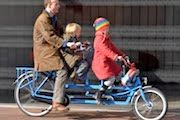
........well not anytime soon. So here are a few of my rainy day ride tips.
We all know that riding in the rain can be a bit miserable and at the same time it can take us to great places of our imagination. Imagining riding the rain soaked streets of Belgium bouncing over the slick cobbles with mud and grit in your face is definitely fun. But riding in the rain takes a little bit of skill. So here are a few of my tips for getting the ride done comfortably and as safely as possible.
1. Wear the proper clothing. As with any inclimate weather you need to be prepared. If it is a cold wet wintery day you'll need at least a base layer, jersey, warmers and a rain jacket. If it isn't so cold you will at least need a base layer, jersey and the jacket. If it is just a little spit of rain you may not need the jacket but pack it in your jersey pocket just in case. For your legs I recommend a good smearing of some great warming embrocation if it is a cold rainy day, covered with a thin layer of vaseline. This is a great way to get the muscles warm and the vaseline layer help keep the heat in and shed the rain water. If it "San Diego cold"(below 60 and above 40) at least wear a pair of knee warmers. Keeping the thin skinned, no fat, unprotected knee joint as warm as possible is crucial. For the feet, it isn't a bad idea to smear a little warming embrocation on them as well, with a little vaseline. I typically wear standard cycling socks and my tube sock shoe covers. This works well for our "cold" days. If you happen to be living in the Midwest where it can be unbearably cold rain you may want to consider a nice pair of neoprene shoe covers and legwarmers or tights.
2. Decrease your tire psi. I like to ride at least 15psi lower when it's raining. so for me that is about 95psi. I am not a big believer in high psi is better so I ride with a lower psi in general and even lower on rain soaked roads. This provides a bit more deformation of the tire in the corners and allows a slightly larger contact patch at the tire pavement contact point. This is always nice. Also, do your best to avoid the painted lines as they are typically very slick when wet. If you happen to be making a turn at an intersection and there are the big white crosswalk lines, slow down appropriately, start your turn, STAY OFF OF THE BRAKES WHILE ON THE PAINTED LINES, say a small prayer and then you should have no problem.
3. Anticipate your braking distance. In the wet it is possible to take a little longer to stop because of the water accumulation on the rims. So if you can anticipate where you'll need to be stopping or using your brakes, stop lights, stop signs, a crash, or something else, give your brakes a light squeeze, just enough to allow the pads to touch the rims surface this will get the excess water off of both the rim and the brake pad and then when you continue your braking to a stop the braking surface will be relatively free of water and other debris and your braking will be safer and almost as quick as on a dry day. But you need to allow a little extra space do do this.
4. Post ride warmth is critical. Alot of people shy away from riding in the rain because they "might get sick" well, you won't get sick from riding in the rain unless you ride by a feces and rain covered road, and that case just keep your mouth shut. But you will get sick if you hang around the bike shop or living room in your wet clothing. You need to get warm as soon as possible. So either pack a bag of warm clothes to take with you in the car while you drive to the ride start, change as soon as you finish riding. Dry off, take off all the wet clothes and put the warm fresh clothes on immediately. At home it isn't a bad idea to get in a hot shower with your wet, grimy cycling clothes on. Rinse your clothes out and get warm all at once. You may need to run this technique by your spouse. If they happen to need the same warm shower, like any shower they are best in tandem. Obviously after the shower get warm clothing on as soon as possible.
5. Watch out! As the rain falls heavier sometimes puddles occur. Which one of those puddles is a hole filled with rain water instead of just a puddle? So approach some puddles with caution. Sometimes it is easy to see that a puddle is only a little deep other times not so much. Also avoid riding into rain filled drain grates as these will eat your front wheel for breakfast, lunch and dinner, these meals are ones that will leave YOU worse off.

Those are just a few of my tips for riding in the rain. Stay safe, smart, healthy and as road rash free as possible.





